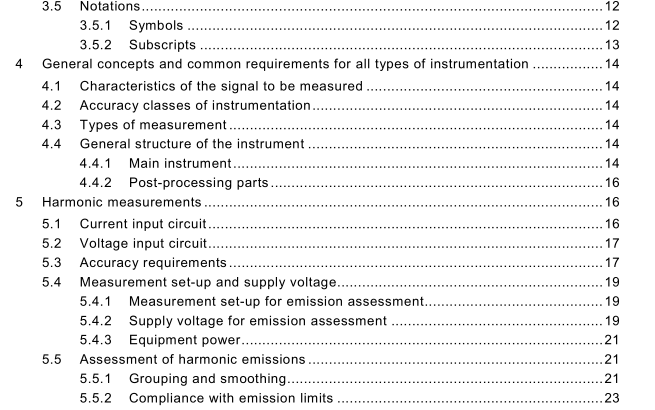IEC 61000-4-7:2009 pdf download – Electromagnetic compatibility (EMC) – Part 4-7: Testing and measurement techniques – General guide on harmonics and interharmonics measurements and instrumentation, for power supply systems and equipment connected thereto
scope
This part of lEC 61000 is applicable to instrumentation intended for measuring spectralcomponents in the frequency range up to 9 kHz which are superimposed on the fundamentalof the power supply systems at 50 Hz and 60 Hz.For practical considerations,this standarddistinguishes between harmonics, interharmonics and other components above the harmonicfrequency range, up to 9 kHz.
This standard defines the measurement instrumentation intended for testing individual itemsof equipment in accordance with emission limits given in certain standards (for example,harmonic current limits as given in lEC 61000-3-2) as well as for the measurement ofharmonic currents and voltages in actual supply systems. Instrumentation for measurementsabove the harmonic frequency range, up to 9 kHz is tentatively defined(see Annex B).
NOTE1 This document deals in detail with instruments based on the discrete Fourier transform.
NOTE 2 The description of the functions and structure of the measuring instruments in this standard is veryexplicit and meant to be taken literally. This is due to the necessity of having reference instruments withreproducible results irrespective of the characteristics of the input signals.
NOTE 3 The instrument is defined to accommodate measurements of harmonics up to the 50th order.
Normative references
The following referenced documents are indispensable for the application of this document.For dated references, only the edition cited applies. For undated references, the latest editionof the referenced document (including any amendments) applies.
IEC 60038,IEC standard voltages
IEC 60050-161,International Electrotechnical Vocabulary – Chapter 161: Electromagneticcompatibility
IEC 61000-2-2,Electromagnetic compatibility (EMC) – Part 2-2:Environment – Compatibilitylevels for low-frequency conducted disturbances and signalling in public low-voltage powersupply systems
IEC 61000-3-2,Electromagnetic compatibility (EMC) – Part 3-2: Limits – Limits for harmoniccurrent emissions (equipment input current s16 A per phase)
IEC 61000-3-12,Electromagnetic compatibility(EMC) – Part 3-12: Limits – Limits forharmonic currents produced by equipment connected to public low-voltage systems with inputcurrent >16 A and ≤75 A per phase
NOTE 2 Strictly speaking these definitions apply to steady-state signals only. The Fourier series is actually in most cases performed digitally, i.e. as a Discrete Fourier Transform DFT, or a variant thereof, being the FFT. The analogue signal f(t) which has to be analyzed is sampled, A/D-converted and stored. Each group of M samples forms a time window on which DFT is performed. According to the principles of Fourier series expansion, the window width T N determines the frequency resolution f C,1 = 1 /T N (i.e. the frequency separation of the spectral components) for the analysis. Therefore the window width T N must be an integer multiple N of the fundamental period T 1 of the system voltage: T N = N × T 1 .
The sampling rate is in this case f s = M/(NT 1 ) (where M = number of samples within T N ). Before DFT-processing, the samples in the time window are often weighted by multiplying them with a special symmetrical function (‘windowing function’). However, for periodic signals and synchronous sampling it is preferable to use a rectangular weighting window which multiplies each sample by unity. The DFT-processor yields the orthogonal Fourier-coefficients a k and b k of the corresponding spectral-component frequencies f C,k = k/T N , k = 0, 1 , 2 … M-1 . However, only k values up to and including half of the maximum value are useful, the other half just duplicates them. Under synchronized conditions, the component of harmonic order h related to the fundamental frequency f H,1 appears as the spectral component of order k, where k = hN.
NOTE 3 The Fast Fourier Transform FFT is a special algorithm allowing short computation times.
It requires that the number of samples M be an integer power of 2, M = 2 i , with i ≥ 1 0 for example.
NOTE 4 The symbol Y is replaced, as required by the symbol I for currents, by the symbol U for voltages. Index C qualifies the variable as spectral component.
3.2 Definitions related to harmonics
3.2.1 harmonic frequency f H,h frequency which is an integer multiple of the fundamental frequency of the power system ( f H,h = h × f H,1 ) NOTE The harmonic frequency f H,h is identical with the component frequency f C,k with k = h × N.
3.2.2 harmonic order h (integer) ratio of a harmonic frequency to the fundamental frequency of the power system. In connection with the analysis using DFT and synchronisation between f H,1 and f s (sampling rate), the harmonic order h corresponds to the spectral component k = h × N ( k = number of the spectral component, N = number of periods of the fundamental frequency in time window T N )
3.2.3 r.m.s. value of a harmonic component Y H,h r.m.s. value of one of the components having a harmonic frequency in the analysis of a non- sinusoidal waveform For brevity, such a component may be referred to simply as a “harmonic”
